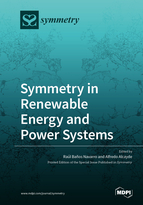Symmetry in Renewable Energy and Power Systems
A special issue of Symmetry (ISSN 2073-8994). This special issue belongs to the section "Computer".
Deadline for manuscript submissions: closed (30 September 2020) | Viewed by 24802
Special Issue Editors
Interests: energy economics; renewable energy; power meters; network analysis; engineering optimization
Special Issues, Collections and Topics in MDPI journals
Interests: power engineering; optimization techniques; ICT
Special Issues, Collections and Topics in MDPI journals
Special Issue Information
Dear Colleagues,
The study of power systems is closely related with symmetry. For example, multiphase power systems are inherently symmetric. The study of symmetrical and asymmetrical faults in power systems is a critical issue. The phase sequence arrangements of multicircuit overhead lines on the same tower directly affects the symmetry of power transmission systems, which influence the operation of power grid and relay protection. Moreover, symmetry is a topic of intensive investigation in the analysis of grid interconnection, including symmetrical and asymmetrical network parameters in smart-grid infrastructures. In renewable energy, the symmetry is present in the layout of wind power plants or photovoltaic plants, among others, while solar systems can have a different performance if they are used with symmetric and asymmetric concentrating CPC collectors.
This Special Issue invites researchers to submit original research papers and review articles related to renewable energy and power systems in which theoretical or practical issues of symmetry are considered. Applied case studies are especially welcome. The topics of interest include but are not limited to:
- Symmetry in the topology of power grids;
- Symmetry in multiphase/polyphase power systems. Power network synchronization;
- Symmetric and asymmetric components;
- Symmetrical and asymetrical faults in power systems;
- Symmetry analysis of phase sequence arrangements of multicircuit overhead lines;
- Symmetry studies of electrical signals using signal processing methods (FFT, DFT, STFT, WT, etc.);
- Symmetry in power electronics devices and renewable energy components;
- Symmetry in renewable energy systems (including smart-grids and micro-grids);
- Symmetrical analysis of power plant layouts and location (including wind farms and photovoltaic plants);
- Algorithms for studying symmetry in renewable energy and power systems.
Prof. Dr. Raúl Baños
Dr. Alfredo Alcayde
Guest Editors
Manuscript Submission Information
Manuscripts should be submitted online at www.mdpi.com by registering and logging in to this website. Once you are registered, click here to go to the submission form. Manuscripts can be submitted until the deadline. All submissions that pass pre-check are peer-reviewed. Accepted papers will be published continuously in the journal (as soon as accepted) and will be listed together on the special issue website. Research articles, review articles as well as short communications are invited. For planned papers, a title and short abstract (about 100 words) can be sent to the Editorial Office for announcement on this website.
Submitted manuscripts should not have been published previously, nor be under consideration for publication elsewhere (except conference proceedings papers). All manuscripts are thoroughly refereed through a single-blind peer-review process. A guide for authors and other relevant information for submission of manuscripts is available on the Instructions for Authors page. Symmetry is an international peer-reviewed open access monthly journal published by MDPI.
Please visit the Instructions for Authors page before submitting a manuscript. The Article Processing Charge (APC) for publication in this open access journal is 2400 CHF (Swiss Francs). Submitted papers should be well formatted and use good English. Authors may use MDPI's English editing service prior to publication or during author revisions.
Keywords
- symmetry
- power systems
- renewable energy systems
- topology
- smart-grids







